2018–19 summer: Soybean on black soil, Bundaberg
Grower: Department of Agriculture and Fisheries, Bundaberg. This is the first soybean crop grown at the research facility. The crop was planted by a contractor using GPS guided machinery. Tim Behrens is overseeing the field operations.
Location: Kalkie, Bundaberg
Monitored area: 10 ha, black soil (irrigation available)
Pre-plant preparation
- Cane harvested. Cane stool removed and trash worked into paddock by several cultivation passes including discing, ploughing and rotary hoeing.
- Knockdown herbicide (RoundUp – Group M glyphosate) applied pre-plant.
- Sodium molybdate was applied before planting.
- Soil is known to have high levels of manganese.
Weeks 1–3
Management notes:
- 12 December 2018 – A6785 soybeans were sown in single rows 650–700 mm apart.
- Inoculated with Soybean rhizobium group H using water injection.
- Seeding rate was between 375 000 and 430 000 seeds per ha.
- 13 December 2018 – Post-emergence and pre-emergence herbicides were applied with Gramoxone for knockdown and Dual Gold for residual weed control.
- No irrigation required, crop grown on moisture stored from rain events. Approx. 40 mm fell around planting.
Week 4

Management notes:
- In the coming week, the small weeds present will be removed using interrow cultivation.
- The roots are nodulating well – large, plump and pink inside.

Week 5:
 Management notes:
Management notes:
- Healthy looking crop with significant growth over the last week.
- Small amount of old chew damage on leaves but did not see the causal agent.
- Inter-row cultivation for weed removal.
- Flower buds are developing.
- New leaves have a shriveled or ‘bubbled’ appearance.
- Tim is watching the weather closely before scheduling an irrigation as rain is forecast.
 Inter-row cultivation.
Inter-row cultivation.
Week 6:

Management notes:
- Crop is green, healthy and filling-out nicely.
- Moderate amount of chew damage on leaves particularly in middle of rows with several stages of heliothis observed.
- A small population of jassids were observed.
- Weed removal operations successfully cleaned up the inter rows, however vine weeds were observed growing within the row and emerging through the crop canopy.
- Flower buds are still developing with more axillary buds appearing this week.
- New leaves still have distortions that seem to be resulting in some scarring.
- 17 January – Irrigation of soybean blocks was underway.
 Vines present within the row.
Vines present within the row.
Week 7
 Management notes:
Management notes:
- Crop is green, healthy and filling-out nicely with the inter-rows almost crowded out.
- Moderate amount of chew damage on leaves particularly in middle of rows with several stages of heliothis observed.
- A significant population of jassids were observed.
- Ladybugs are also present in this block of soybeans.
- Flower buds are opening, and the first flowers have emerged.
- An irrigation was made within the last 24 hours, and one earlier in the week.
- Tim is preparing to carry out a spray to control the Heliothis and is looking at using biological options such as Bts to protect the beneficials. He is also monitoring the crop 1-2 times per week.
 First flowers are emerging.
First flowers are emerging.
Week 8

Management notes:
- Crop is green, healthy and growing vigorously.
- Moderate amount of chew damage on leaves, particularly in middle of rows, however the heliothis observed were quite slow moving and unwell after an application of bio-insecticide Bacchus WG
- A moderate population of jassids were observed as well as a population of beneficial ladybugs.
- Vine weeds were observed to be climbing up the soybeans however an application of Vezir pre- and post-emergence herbicide was applied with the Bacchus WG bio-insecticide
- Flowers have emerged at apical and axillary positions.
- An irrigation is scheduled for next week unless rainfall occurs beforehand.

Week 9

Management notes:
- Crop is green, healthy and growing vigorously with 95% canopy closure.
- Small amount of old chew damage on leaves particularly in middle of rows however heliothis were not observed.
- A small population of jassids and whitefly were observed as well as a population of beneficial ladybugs and ladybug nymphs.
- A small number of loopers were observed but not enough to warrant any action.
- Vine weeds were observed to be climbing up the soybeans, but don’t seem to be affecting the health of the plant at the moment.
- Flowering has mostly ceased, getting ready for pod development.
- February 7th an irrigation was occurring at time of crop inspection and with the canopy closing over the good soil moisture will hopefully be retained longer.
 Flowering is ending, marking the beginning of pod development.
Flowering is ending, marking the beginning of pod development.
Week 10
 Management notes:
Management notes:
- Irrigation is very important at this time as the crop is filling pods so any moisture stress will impact on yield. Irrigate to minimise wilting.
- There are some monolepta around in the crop especially on the edges. These pests can appear in hot spots and can cause quite a bit of damage in a short time. They are not hard to control but as they are not in large enough numbers yet we can wait to see if grub numbers increase, warranting a spray.
- There is some old damage from grub feeding visible but grub numbers are still low.
- There are Jassids present but not in large enough numbers to need treatment.
 Monolepta are present in hot spots but numbers are not sufficient to warrant control at this point.
Monolepta are present in hot spots but numbers are not sufficient to warrant control at this point.
Week 11

Management notes:
- Evapotranspiration rates of 7-8 mm per day make it a struggle to keep water up to crops in full pod fill.
- Green Vegetable Bugs are increasing in numbers in one part of the block but are not widespread. We’ll keep an eye on the block, which may require treatment next week if the area affected increases.
- Green Vegie Bug are the main issue now as pods are at a vulnerable stage.
- Treatment is not required just yet as the Monolepta have moved on and the grub pressure is very light in this block.
 Monitor for Green vegetable bug (GVB), which can do serious damage to the pods at this stage of the crop.
Monitor for Green vegetable bug (GVB), which can do serious damage to the pods at this stage of the crop.
Week 12–13
 Management notes:
Management notes:
- Crop is green, healthy and growing vigorously with full canopy closure despite the hot and dry conditions. The canopy closure will be helping moisture retention in the soil.
- A small population of whitefly still present, as well as small numbers of green vegetable bug (GVB), redbanded shield bugs and monolepta observed.
- Good pod set, development and filling was observed.
- Bronzing of the leaves was observed which could be attributed to sunburn or wind rub.
- Irrigation of the block will be occurring today and is roughly operating on an 8-day cycle.
- Tim will be monitoring the crop to watch for an increase in the GVB population over the next week.
- Herbicide will be applied at the end of the rows to prevent weeds creeping into the soybeans.
 Adult green vegetable bug
Adult green vegetable bug
Week 14:

Management notes:
- Crop is green, healthy and growing vigorously. The canopy closure is helping to maintain good soil moisture. Water available to the crop if they need it and irrigation is occurring regularly.
- A small population redbanded shield bugs was observed today but numbers not large enough to warrant spraying.
- Good uniform pod development with very few aborted pods present.
- Vine weeds are still present in the crop. To prevent further weeds particularly the vine weeds entering the interrow a herbicide application was given to the ends of the rows today.
- Tim will be monitoring the crop to watch for an increase in pest species as well as keeping water up to the crop this week.
 A small population redbanded shield bugs present.
A small population redbanded shield bugs present.
Week 15
 Management notes:
Management notes:
- Crop is green, healthy and growing vigorously. Good soil moisture and irrigation still a high priority.
- A significant population of GVB third and fourth instar nymphs, as well as a moderate population of fifth instar GVB nymphs observed, mainly in hotspots in the crop.
- Small populations of redbanded shield bugs and their nymphs and loopers were also present.
- Good uniform pod development with very few aborted pods present. Could be close to harvest time.
- Tim will be scheduling an insecticide application of Decis Options plus salt for the control of the GVB and redbanded shield bug populations, which will also clean up the loopers.
 Small populations of redbanded shield bugs and their nymphs
Small populations of redbanded shield bugs and their nymphs
Week 16

Management notes:
- Crop is green and healthy. Rainfall this week will reduce reliance on irrigation to finish this crop.
- Pests were not observed today in any worrying numbers however monitoring for pod suckers regularly is still advisable.
- Pods are maturing. The pod is getting harder and some are turning yellow. A lot of triple pods were observed with a smaller percentage of doubles.
- The last irrigation was made on Tuesday and there are no more planned at this stage before harvest. Pods will be checked this week for maturity to determine how many weeks off harvest they are.
- Some plant collapse was observed today, as a result of incorrect row/wheel track spacings on the spray rig running over a few rows.
 Pods will be monitored for maturity to determine best harvest time
Pods will be monitored for maturity to determine best harvest time
Week 17

Management notes:
- A small population of redbanded shield bugs and GVB nymphs were observed today, mainly in the plants that are still green.
- We are in late pod fill stage with leaf senescence well under way, especially in those plants at the end of the rows.
- We are estimating that harvest could be in about 2 weeks but have not conducted any formal maturity tests.
 Harvest is imminent in this black soil block.
Harvest is imminent in this black soil block.
Week 18

Management notes:
- We are in late pod fill stage with leaf senescence well under way. Not a lot is different from last week except a further progression of leaf yellowing throughout the crop.
- A small amount of varying maturity is still observed in the crop however some beans may still make it before harvest.
- We are estimating that harvest could be in about 2 weeks and will be advised 1 week in advance to spray Reglone herbicide to desiccate the crop in preparation for harvest.

Week 19
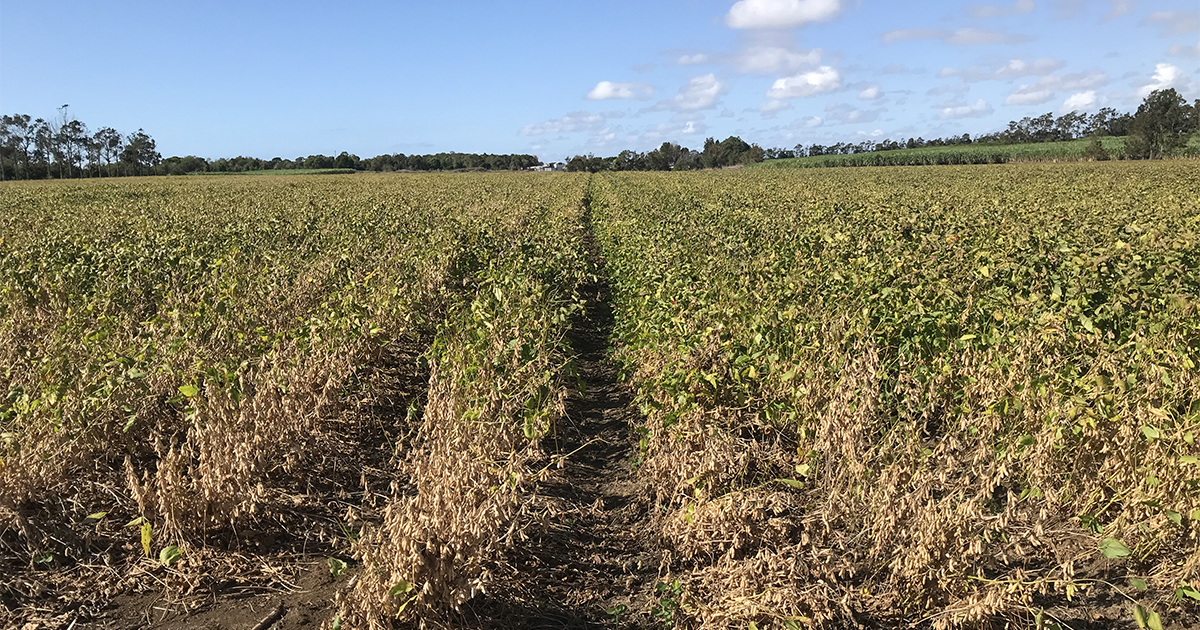
Management notes:
- The soybeans in the block appear to be of a more uniform maturity now and are ready for the harvester.
- A sample of soybeans examined today show a small number that have been affected by podsuckers but the majority were plump and round.
- We are hoping to be advised of a harvesting date in the coming week so that Tim can spray out the crop and existing weeds with Reglone herbicide about 5 days before harvesting.
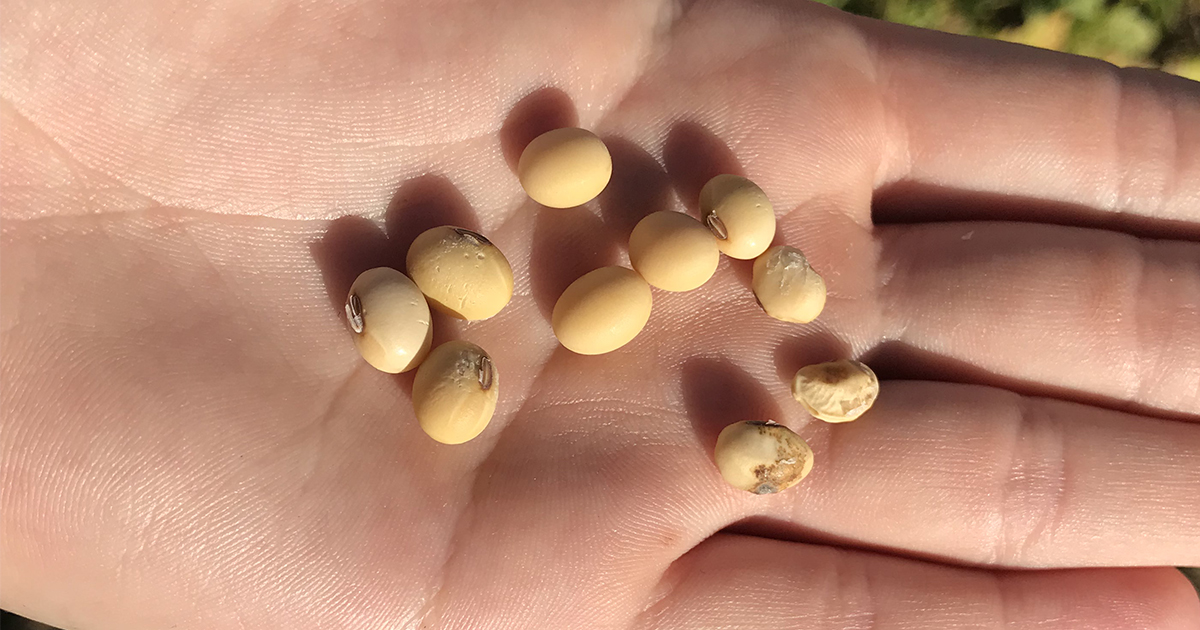 Some evidence of podsucker damage but overall a nice looking sample.
Some evidence of podsucker damage but overall a nice looking sample.
Week 20
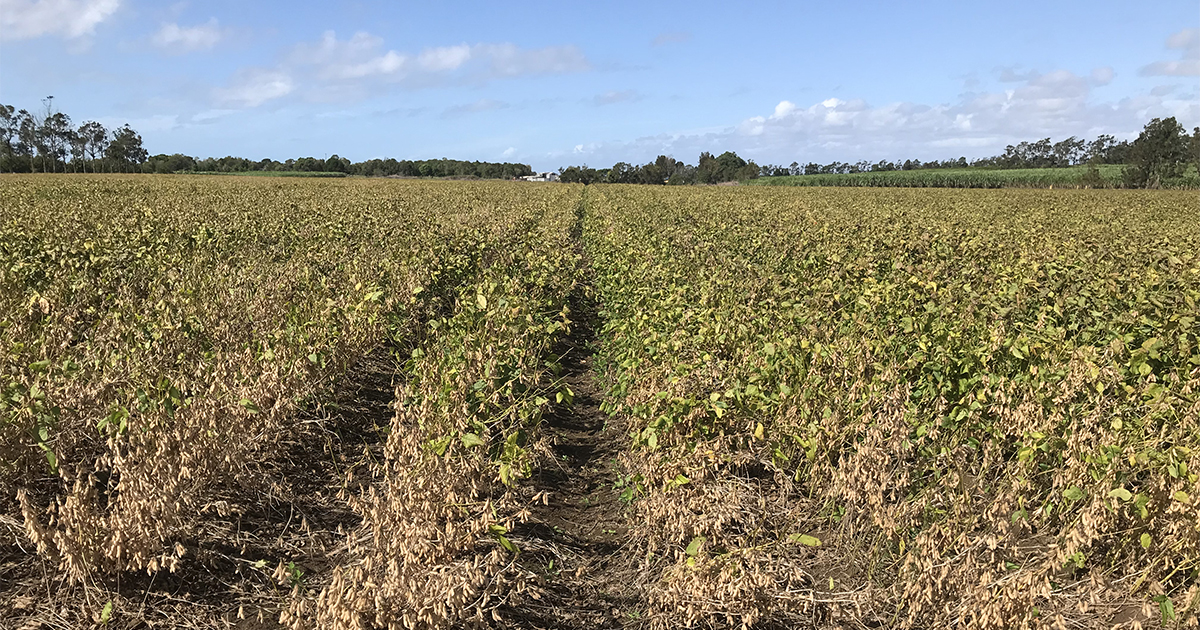 Management notes:
Management notes:
- It is now a waiting game for the harvester. Plant desiccation is occurring however there are still many plants that are relatively green and leafy still.
- Small weeds are appearing again in the paddock. This is not really an issue for the current soybean crop but may mean increased pressure in the next crop. Use of Reglone herbicide to spray out the soybeans will also control these weeds.
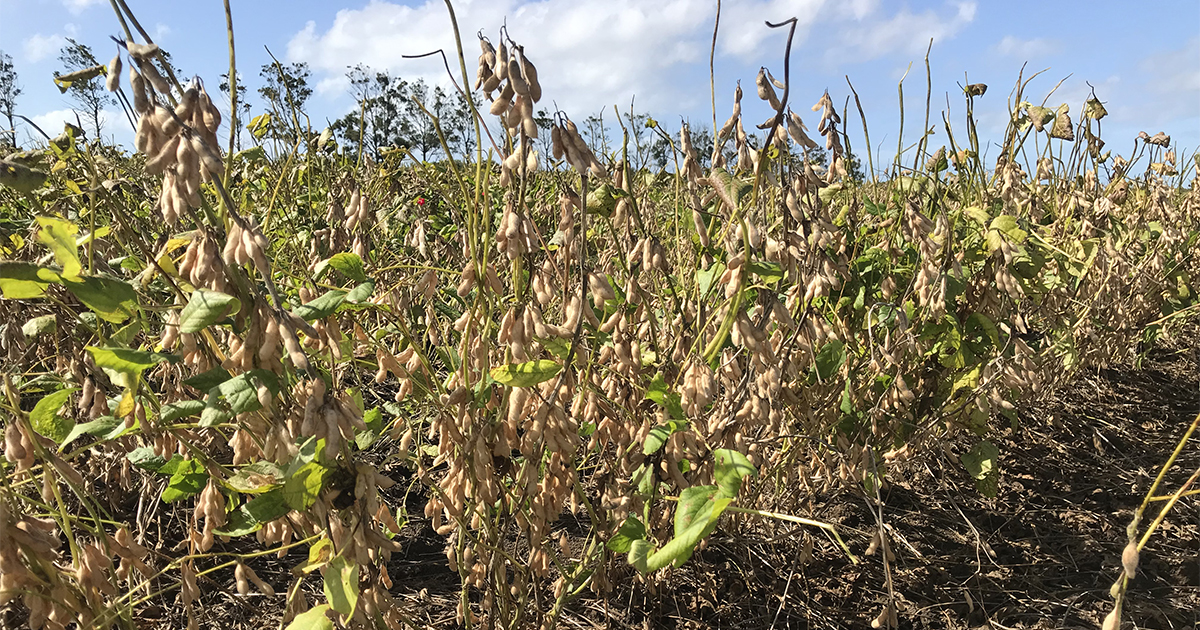 These few green weeds will need to be killed and dried down before to protect the grain from staining.
These few green weeds will need to be killed and dried down before to protect the grain from staining.
Week 21
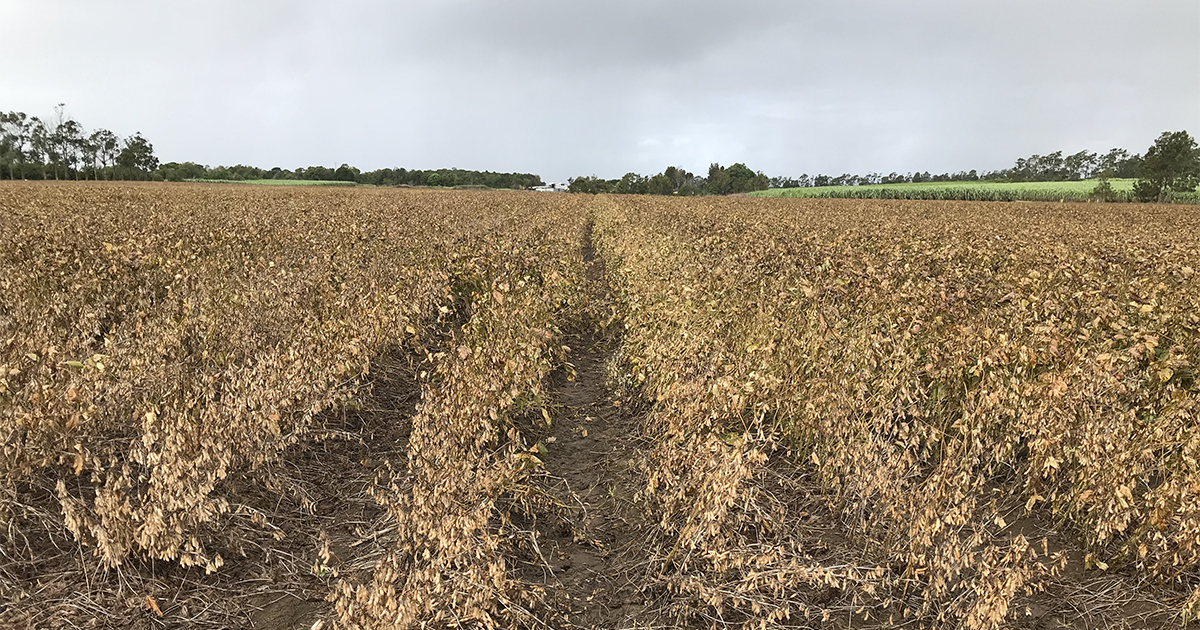 Management notes:
Management notes:
- Reglone herbicide was used to desiccate the crop within the last week. Harvesting is expected in about 7–10 days.
Week 22
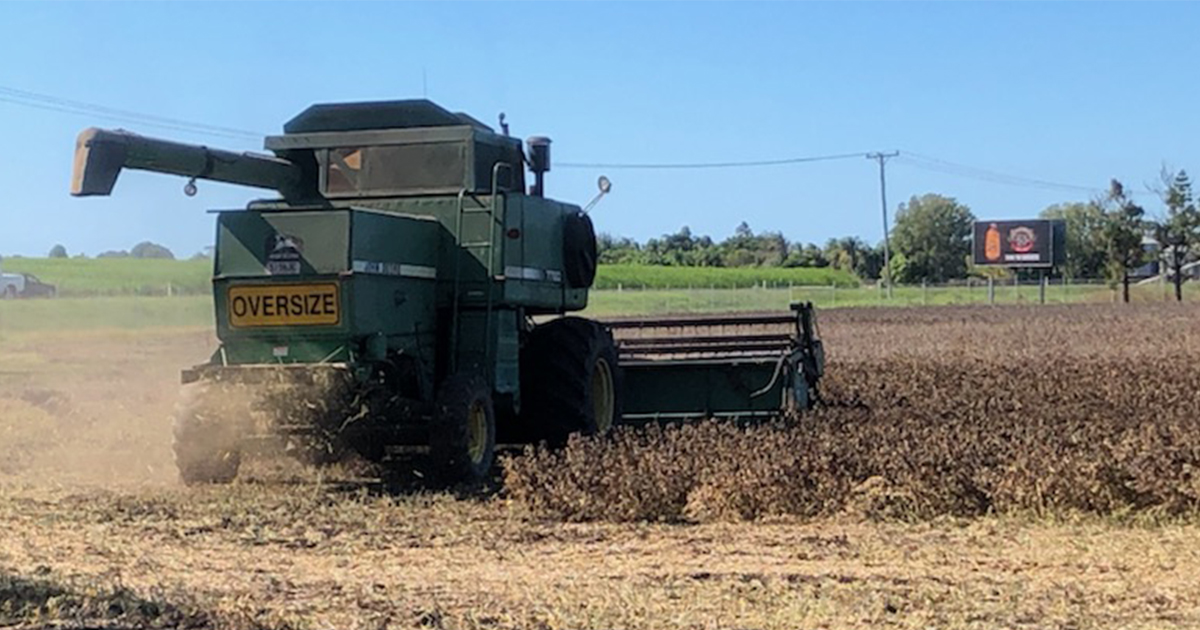
- Soybeans were harvested last week with an estimation of 35t recorded for the block. Yet to receive official figures though.
- Harvesting went well; however it came a little bit late as some pods had opened and the grain starting to germinate in the paddock.
Read Pulse Check blog articles | Pulse Check Coastal facebook | Subscribe to the monthly newsletter



